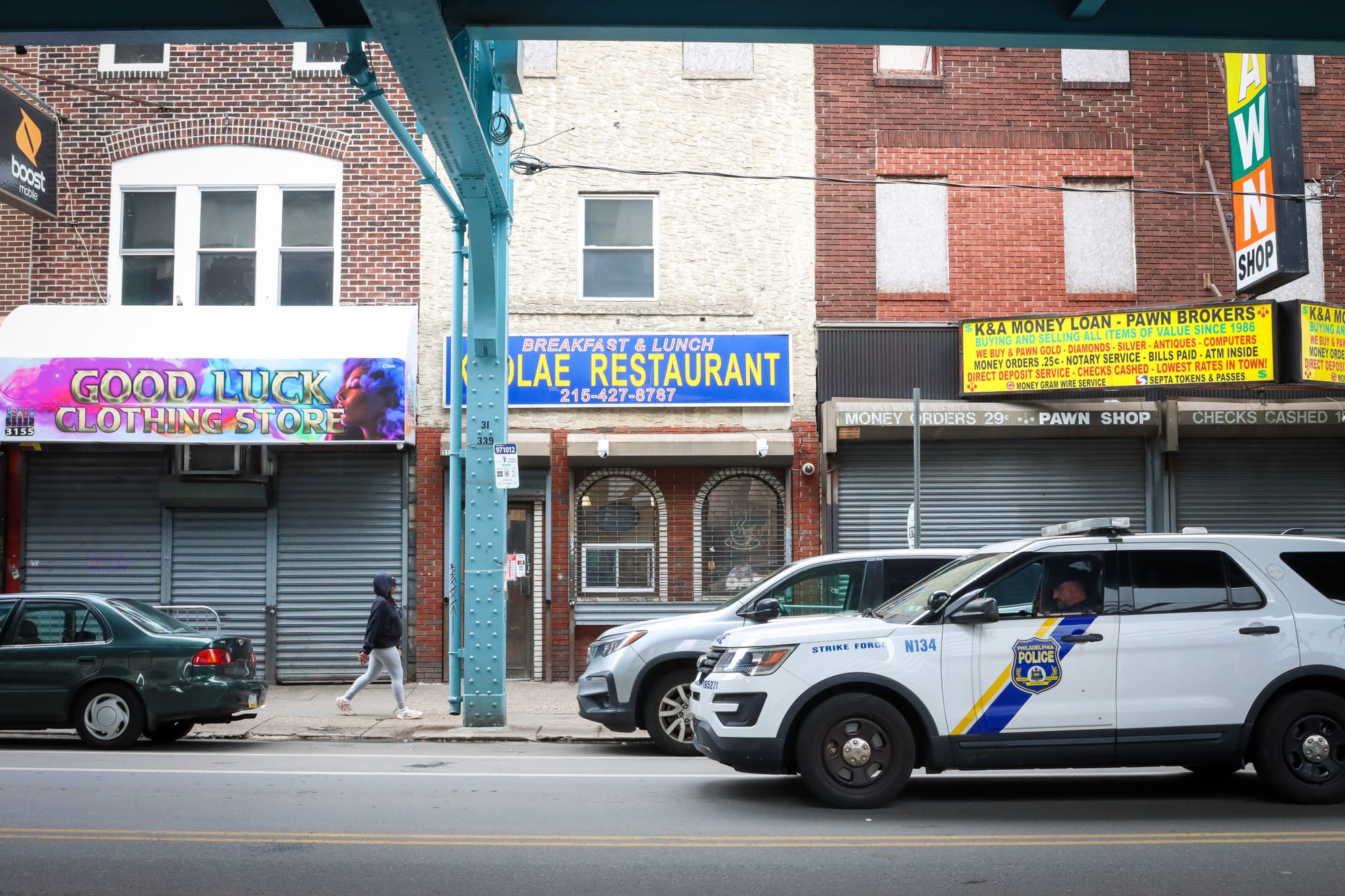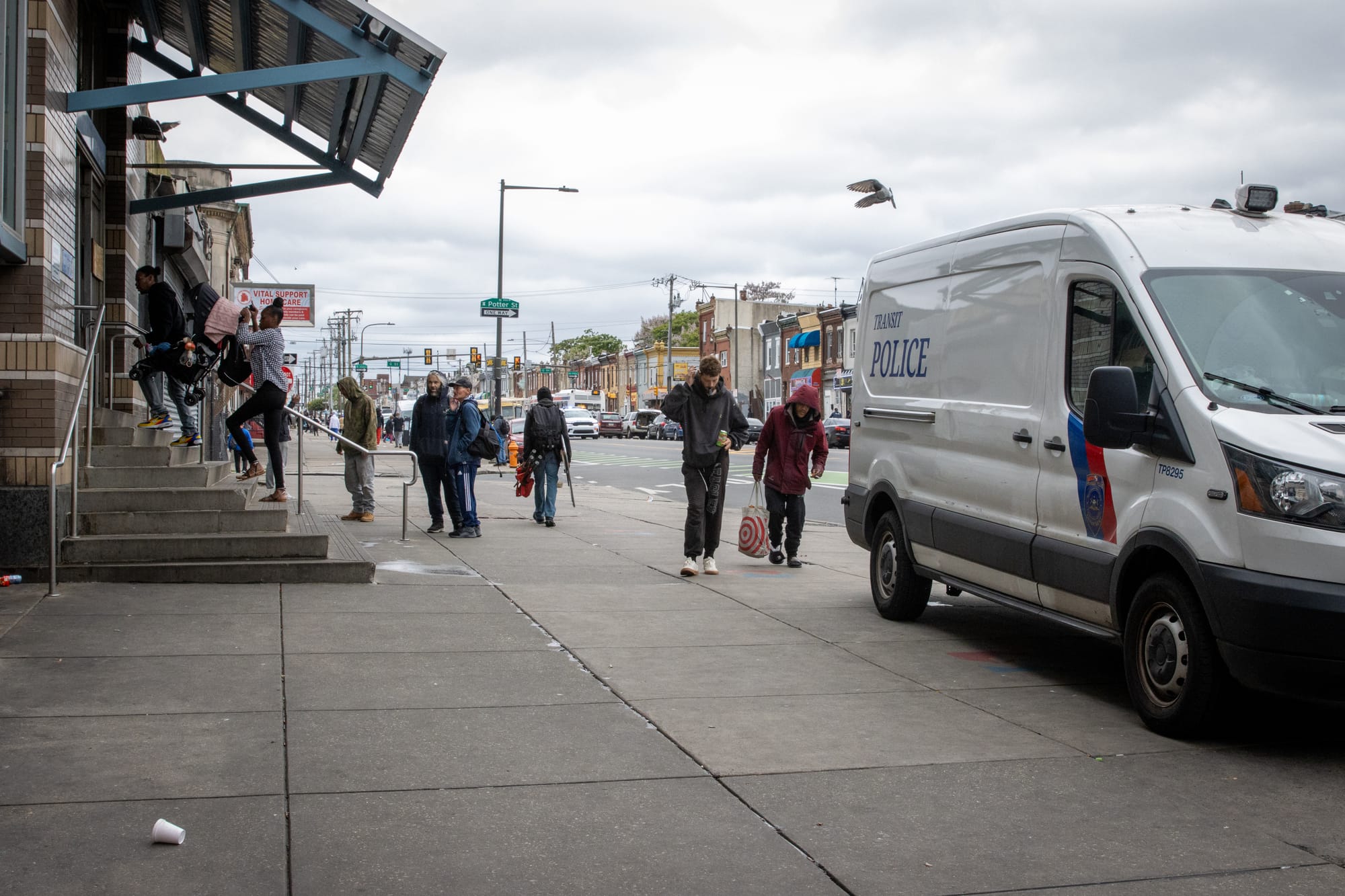A last-minute gift that funds local news for Kensington
They get a certificate. You get a tax deduction. Kensington gets reporters.
Some residents feel safer, while others say the spillover from the sweep and increased police presence has caused problems on side streets.

About 24 hours after Philly police and sanitation workers cleared an encampment on a two-block stretch of Kensington Avenue last week, Mary Jones flagged down a Philadelphia Police Department cruiser parked on the sidewalk on Allegheny Avenue.
Jones, who has lived on a side street off of the Allegheny corridor for about 15 years, asked police to tell a woman who was slumped over on her neighbor’s stoop to move. The officers reversed their SUV, and within minutes, the woman was gone.
“What the mayor is doing – I applaud her, I really do,” she said. “But if you’re gonna get rid of the addicts, get rid of the drug dealers because they’re still here.”
Like many Kensington community members, Jones wonders whether the ramped-up police presence that has lingered since the May 8 encampment sweep will translate to lasting change in the neighborhood. The city has continually made promises to connect people to treatment and shelter while openly admitting that there are not enough beds to meet demand.
Jones worries about what children in the neighborhood witness and wants to see people in need get help. Her brother is addicted to opioids and lives in an abandoned house. She suggested the city reopen closed schools or hospitals, such as the Philadelphia State Hospital at Byberry and Hahnemann University Hospital to keep people off the street.
“At least they’d have a room, heat, hot water, three meals, and a cot,” she said. “Y’all got room – open up one of those hospitals.”
City officials recently announced that they are adding shelter beds to a former nursing home at 21st and Girard Avenue. Still, it’s unclear whether anyone was placed there after the encampment sweep last Wednesday.
“There remains much more work to be done as the Parker administration works to build out a comprehensive system of long-term care, treatment, and housing for individuals suffering from addiction to substances, mental health challenges, and people experiencing homelessness,” a city spokesperson wrote in an email on May 1.
The Philadelphia District Attorney's Office also announced a slew of drug manufacturing and distribution charges on Thursday against a Kensington resident after investigators recovered 1,100 baggies of fentanyl from her residence on one of the former encampment blocks.
While the tents are gone from Kensington Avenue, unhoused individuals are still lugging their belongings down the sidewalks looking for help.
“It shouldn’t be this hard,” said Heidi, who declined to provide her last name.
On Thursday morning, Heidi was trying to get placed at the 21st and Girard shelter, but the outreach worker she spoke with told her there were no open beds for women.
“There’s all these shelters, but you shouldn’t have to do this song and tap-dance to get in,” she said. “All I’m trying to do is find a stable place to stay.”

On the morning of the clearing, police officers and sanitation workers dispersed people before they could receive services, contrary to what the city said would happen just two days earlier.
While 31 people received city services the day of the sweep, only four of them were on the list of people staying in the Kensington Avenue encampments, according to a spokesperson for the Managing Director’s Office. Instead of connecting with city services, most people scattered to residential blocks.
Now, barricades line each of the cleared blocks, and the number of police officers in their cars, on bikes, and on foot in the vicinity has increased.
Mike, who requested to go by first name only because of his illicit drug use, has been buying drugs in Kensington for 33 years. He avoided the neighborhood the day of the sweep because he had drug-related arrest warrants but returned the next day and went to Willard Street.
“I’m just staying off Kensington Ave.,” he said.
Residents say the spillover from the sweep and increased police presence has caused problems on side streets.
“They’re going into backyards, and they’re urinating,” said Wendy, who has lived in Kensington for 30 years. “I live a couple of blocks away, and they never went that way – and now they’re that way.”
Wendy, who asked to go by her first name only for privacy reasons, manages Koolae Restaurant on the 3100 block of Kensington Avenue. She said business has slowed because the neighborhood’s unhoused people were spending their money there, and police won’t let paying customers smoke cigarettes outside the restaurant anymore.
“A lot of the shop owners are upset … [police] are being ignorant not only to the homeless but to the customers,” she said. “If somebody happens to just come up to the restaurant and stand in front of the door, they want you to move.”
She doesn’t know the answer but said it starts with people having a place to go for housing or treatment before they’re told to move.
“You’re moving the people, but where are you moving them to?” she said. “You’re not giving them any homes, no help for drug addiction, so now you’re just moving them from one side to another side.”

Kensington resident Isabel Torres says something as simple as taking out five dollars to buy a soda can create a dangerous situation. Last week, she was doing just that when someone swiped her cash, she said.
“I’m screaming to everybody, ‘help me, help me, he took my five dollars,” said Torres, who lives on one of the newly barricaded blocks on Kensington Avenue. “... I had nobody out here to defend me. Why? Because they were all on the floor sleeping.”
Torres fully supports the encampment sweep, barricades, and increased policing.
“They need that in this neighborhood,” she said. “That’s a good thing.”
Since last week’s clearing, Yaleidie Grone, who lives with her two-year-old daughter, said an influx of people has impacted her street, and someone recently urinated across the street from her house. But she also said she’s seen fewer needles and unhoused drug users when she needs to commute.
“My daughter has doctors’ appointments, and I have to take the train and everything, and sometimes there’s drug users on the train that don’t even care that you’re there with a child,” said Grone. “But I haven’t seen none of that so far after they did that [last week].”
Grone hopes the city continues what it’s doing and sticks to their word.
“Hopefully, everything gets better because I don’t want my daughter growing up with all the gun violence, drug usage, just violence in general,” she said. “I don’t want her to grow up like me.”
For 11-year-old A-ala, who lives near the El station at Kensington and Allegheny avenues, the cleaner intersection and policing increase have not gone unnoticed.
“It’s a lot cleaner and they try to get a lot more security,” she said. “In fact, I live near a police station, and it’s like police cars everywhere where I live.”
A-ala thinks the increased policing is the city’s attempt to make the neighborhood safer for children and adults. But she also echoed others’ concerns about displacing unhoused residents.
“I think they should try to get them off the drugs instead of moving them away and completely avoiding the problem,” A-ala said.
Have any questions, comments, or concerns about this story? Send an email to editors@kensingtonvoice.com.
Free accountability journalism, community news, & local resources delivered weekly to your inbox.